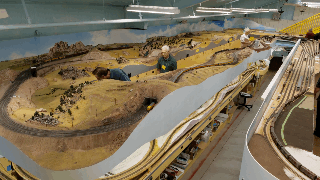




Types of Sessions
The Wyoming Division hosts three types of operating sessions. All are complete sessions with the possibility of running all types
of trains and all types of operations. The differences are basically the guests that attend.
•
Regular Monthly: See the Calendar below. Most sessions are open to all operators, but Reservations are suggested. We
have never had to turn anyone down—always room for one more on this very large layout.
o
I generally send out invitations 10 to 14 days before sessions from a Groups.io, WyoDivOps. Previously, I used a
Yahoo Group. That Yahoo Group still exists, but it is not active.
o
The Groups.io group is at https://groups.io/g/wyodivops/topics In the invitation is a link to a Google Sheet (an Excel-
like interactive spreadsheet) that you can type your name on under a job to reserve that job. After you type your name
under a job and press [Return] the Google Sheet is automatically updated, so all of us, and I can track who is signing
up.
o
The Groups.io is at https://groups.io/g/wyodivops/topics To join you must be approved. Only operators or enthusiasts
who would like to try operations should join. As a member you would receive a lot of emails about our operations, so
non-operators would be bothered by a lot of such posts. Contact me at the email below to express an interest in
operations to receive an invitation.
o
You must be a member of the Group to enter it. This requires approval from Verryl. To join Group, write Verryl at
wyodivops@gmail.com , tell him about yourself, and your interest in operations, and he will have Groups.io send you
an invitation. Verryl will be notified back, so he can approve you.
o
To reserve a job or space to operate if you are just coming through town (2nd Saturday, generally) write Verryl at
above email to notify him you are coming.
•
Special Ops: Occasionally we hold special sessions for special groups, and these may not be open to the public. Only the
regular, open sessions are on the calendar below.
•
We hold annual 3 day events similar to Bay Rails, Rocky Mountain Ops, or SoCal Ops, only all op sessions are at the
Wyoming Division.
o
These Invitationals consist of a Thursday layout open house and BBQ
o
Friday operate all day 9 to 4
o
Saturday, operate 9 to 4, and then a prime rib banquet.
o
The photo below was taken at a banquet.
o
Wives are encouraged to come—Sharon is a great party giver and tour guide for the weekend.
Schedule of Operating Sessions (Calendar)
The annual 2018 calendar may be seen by clicking the link to the right.
Upcoming News: See the “News” Tab for the latest Calendar
DESIGNED AND BUILT FOR HISTORICAL ACCURACY AND OPERATIONS
The layout was built specifically for operations which will feature.
•
Long, through freight trains (25 or more cars plus engine, tender and caboose)
•
Long drag freight trains across the entire layout including LCL pickups and setouts at 11 freight houses and numerous team
tracks
•
Local freight trains that will be confined around Cheyenne (2 within the yard); Cheyenne to Green River West; Ogden to
Green River East; and in Ogden and the vicinity (1 within the yard and one of 68 miles to Park City, Utah)
•
Interchange with Southern Pacific; a UP train brings a string of cars from the Ogden-Riverdale yard to an interchange track
in Downtown Ogden and picks up loads and empties from the interchange track to return to UP. The Downtown Ogden SP
Local then works the 13 industries in Downtown Ogden until another UP train is needed.
•
MOW Work trains as required
•
Coal, iron ore, cement, trona (soda), and oil product trains from 2 coal mines, 1 iron ore mine, 1 cement plant, a trona mine,
and two refineries
•
The Laramie Tie Treating Plant, the Granite rock quarry, the Wycon Chemical Plant (fertilizer from the soda), and the Ideal
Cement Plant are other local trains run by YM’s
•
PFE trains will run across the layout with a few stops on the layout (for icing in Ogden and in Laramie and to set out or pick
up an occasional car)
•
Stock trains will serve Utah and Wyoming and the packing plants
•
4 named Streamliner “City” (LA, San Francisco, St. Louis, Portland) passenger trains, the Challenger Heavyweight
Passenger train, and a few mixed trains for local passenger service and local freight
•
Helper service will be required up Sherman Hill West from Cheyenne and East up the Wasatch Mountains out of Ogden.
•
There are two lengths of main line track that require left hand running, so the correct current of running, left or right, must be
observed. These two areas are prototypical requirements due to grade differences in new and old tracks built years apart.
•
These Sherman and Wasatch grades require changing heavy loco power for lighter units across the nearly level “bowl” of
Wyoming, so we do that at Laramie and at Green River.
“Operations” means having a model railroad party. We really enjoy the cooperative nature of “ops,” that is, running a lot of
trains with the express purpose of moving passengers and freight from A to B as if to make a profit or at least efficiently, like real
railroads try to do. It involves dispatching, calling engineers to run, running, switching, yard work of classification or loco
changes, engineers bringing trains into and out of yards with the cooperation of yard crews, and helper operations. All these
have the goal of delivering freight or passengers or picking up empty cars. Like real life it takes a lot of workers to accomplish
the work of a real railroad, and that working together is a lot of fun. The bottom line is modelers take great pains to make layouts
that look and sound like real scenes. Operations attempts to carry that realism into running the trains. And no one is scolded or
embarrassed if we make a mistake—after all we only do it once a month, not 40+hours a week.
A “spot” in railroad terminology is a place to place a car for loading, unloading, or storage. It is where a crew “spots” a car,
so called for precision placement to facilitate loading or unloading. There are 906 spots on the Wyoming Division model railroad,
and most of them attempt to model or at least represent real industries and loading and unloading locations on the 1957 UP
Wyoming Division. Generally, the industries with spots that appear on the layout had real counterparts in 1957 and they are
located approximately where they were with respect to the more recognizable towns, junctions and yards. In one case, Ideal
Cement, near Echo, the plant is on the wrong side of the tracks, but this is “modeling license;” the bench end cap at Echo was a
natural for that town and junction, because the real tracks make a 90°turn from SE to NE. It was necessary to place the main line
tracks near the edge of benches (benches 1/2 and 2/3) to make the radius large. The space left inside the model’s 180°curve
was an obvious place to place a large industry like a cement plant, but in Utah, the real plant is some distance from this bend at
Echo.
A very large percentage of all the other industries represent real counterparts in layout and location with respect to towns,
but of course they are scaled down in size like all models. There are a very few industries on the layout that are not good
representations of Wyoming and Utah in 1957.
To manage and remember the spots, an 8-page table is used in operations. Part of one page is shown here. The table is
arranged by location, east to west, and color coded as to type of car is reasonable for it to require. For example, a stock car
would not be appropriate for a grain mill or a refinery. Nine types of cars are used on the model, and there is a color and column
for each.
JOBS ON THE WYOMING DIVISION
There are the following jobs on the Wyoming Division for modelers to fill when they operate. Each has a high degree of realism
to the real job, except there is no heavy lifting or dirty hands.
Dispatcher (if 2, each dispatches one level, upper or lower)
1 or 2
Trainmaster/Tower Operator Cheyenne (manages turnouts,
1
arrival and Departure of trains in Cheyenne A/D tracks, directs
trains to correct Classification yard per Cheyenne YM)
YM’s (Cheyenne, Laramie, Green River, Ogden)
4
Hostlers (Cheyenne, Laramie, Green River, Ogden, also
act as Tower Operator job communication with Dispatcher)
4
Classification Foreman ((Cheyenne, Laramie, Green River, Ogden)
4
Staging (2 if real time staging is used—requires 2 expert yard men,
or 1 or 0 if 4 hour session with few expert operators and all trains
pre-staged
0-2
Coal Jobs (Coal Agent, Engineer/Conductor for 2 coal drags)
2 jobs total
locals (optional: 2 in Cheyenne, 1 in Ogden,
Downtown Ogden SP interchange job
1
Road Locals (Park City Local, Rock Springs Road Switcher
4
Cheyenne to Green River West, Green River to Cheyenne East)
2
Passenger Trains (4 City Trains—SF, Portland, St. Louis, LA
1 or 2
Heavyweight Challenger, 1 or 2 mail) 2 to 4 run concurrently
2-4
Road Crews (1 or 2 man crews for Conductor/Engineer—1 can
handle the job
any
Total (we never had too many)
40 (we have had as many as 50)
OPEN INVITATION TO OPERATE: All are welcome to operate on the Wyoming Division. We have especially made the
operating system (the single trick car card car forwarding system) simple to operate and learn. You should have no
hesitancy to get into ops using this simple method. You can then go on to more complicated 4 cycle car card systems or
switch list operations and work your way up even to Time Table and Train Order ops (TT & TO).
To make a reservation or enquiries write Verryl at wyodivops@gmail.com
























